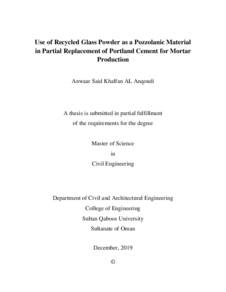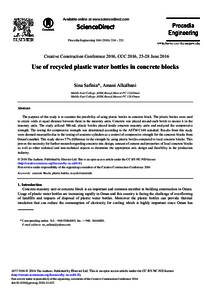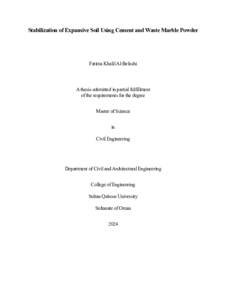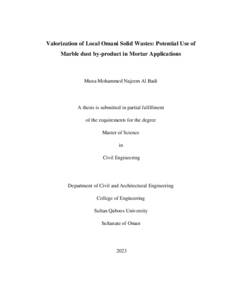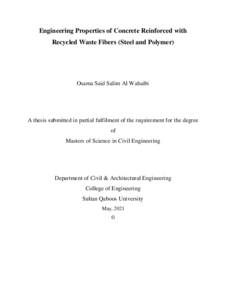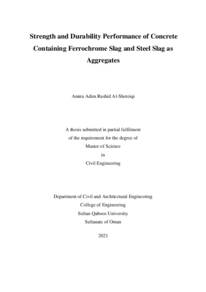Document
Use of recycled glass powder as a pozzolanic material in partial replacement of portland cement for mortar production.
Identifier
Al-Anqoudiyah, Anwaar Said Khalfan (2019). Use of recycled glass powder as a pozzolanic material in partial replacement of portland cement for mortar production (Master thesis, Sultan Qaboos University, Muscat, Oman).
Publisher
Sultan Qaboos University.
Gregorian
2019
Language
English
Subject
English abstract
In industry, as well as in cities, a large amount of solid waste is produced, some of which
is partially recycled or is disposed of in its entirety in landfills, thereby generating
negative environmental impacts. Of this waste, industrial waste glass from many
application sources is a major source of pollution. In developed countries, efficient glass
recovery and recycling systems are well implemented to avoid waste glass landfilling and
its disastrous environmental and economic effects. Yet no effective glass recycling
system is established in Oman and many other developing countries which lead to a huge
amount of waste glass landfilled and thrown out in the ground. This causes a considerable
economic loss and environmental issues.
In the search and for an alternative exploitation of solid waste, various applications have
arisen, some of which are related to constructions sector. This research study the use of
mixed color waste glass fragments collected from a local Aluminum workshop in
Maabilah, ground to approximately a size of cement and used at various replacement
levels of Portland cement in mortar production. The results shows that this replacement is
possible and even lead to an improvement to some mortar properties if the amount of
cement and the glass powder (GP) in the mortar mix are well optimized. Out of this
research, GP can improve the flowability of mortar and reduce both water and
superplasticizer (SP) demand. The use of GP enhanced the long-term compressive
strength, led to a better resistance against chloride penetration, acid and sulphate attacks.
The combination of conventional supplementary cementitious materials with GP reveals
to be very efficient and promising. Moreover, the use of GP in the mortar has resulted in
a reduction in the thermal conductivity and hence a better heat insulation property.
Member of
Resource URL
Arabic abstract
في الصناعة وكذلك في المدن ، يتم انتاج كمية كبيرة من النفايات الصلبة ، البعض منها يتم إعادة تدويرها بشكل جزئي أو يتم التخلص منه بالكامل في مدافن النفايات ، مما ينتج عنه آثار بيئية سلبية. من هذه النفايات ، يعتبر زجاج النفايات الصناعية من العديد من المصادر مصدًرا رئيسيًا للتلوث، في البلدان المتقدمة يتم تنفيذ أنظمة فعالة إلعادة تدوير الزجاج وإعادة تدويره بشكل جيد لتجنب رميه في مدافن النفايات الزجاجية وتأثيراتها الكارثي في البيئية والأقتصاد ، حتى الأن لم يتم إنشاء نظام فعال إلعادة تدوير الزجاج في ُعمان والعديد من البلدان النامية الأخرى مما يؤدي إلى ضخ كميات كبيرة من النفايات الزجاجية وطمرها في الأرض. هذا يسبب خسارة اقتصادية كبيرة ومشاكل بيئية. في البحث عن نتيجة بديلة للنفايات نشأت تطبيقات مختلفة بعضها يرتبط بقطاع الأنشاءات. يدرس هذا البحث استخدام شظايا نفايات الزجاج الملون المجموعة من ورشة الألمنيوم المحلية في المعبيلة ، والتي يتم طحنها لحبيبات بحجم الأسمنت وتستخدم بنسب مختلفة كبديل لإلسمنت في إنتاج الملاط. أظهرت النتائج أن هذا الأستبدال ممكن و يؤدي إلى تحسين بعض خصائص الملاط إذا كانت كمية الأسمنت ومسحوق الزجاج )GP )متوازنين في مزيج الملاط ، من هذا البحث وجد انه ال يؤثر GP على درجة حرارة الملاط فور الخلط ويحسن من قابلية السيولة بحيث يساعد على الحفاظ على الموارد المائية، كذلك تساعد جزيئات الزجاج في تطوير قوة الضغط على المدى الطويل وأثبتت ان وجوده في الملاط يعزز خاصية العزل الحراري، عالوة على ذلك ، وجود GP في الملاط يؤدي الى مقاومة أفضل ضد تغلغل الكلوريد والتأثير الأحماض والأمالح ومع ذلك ، دمج GP في المزيج يؤدي إلى زيادة المسامية وتقليل في قيمة UPV والتي تؤثر على كفاءة الملاط.
Category
Theses and Dissertations

